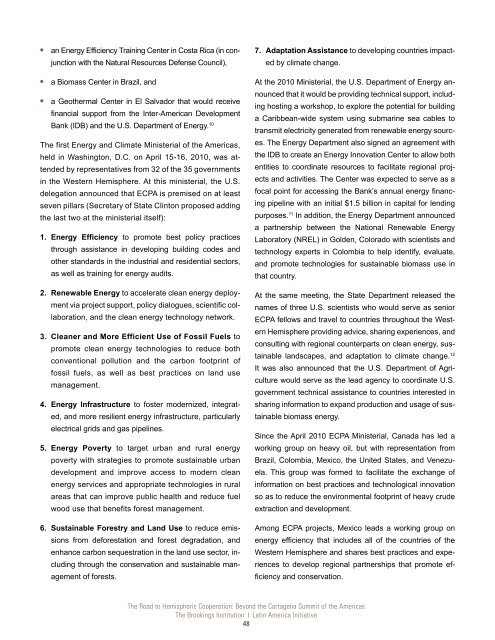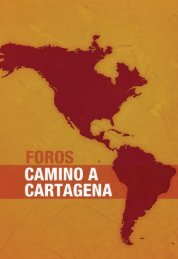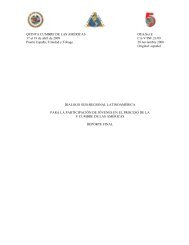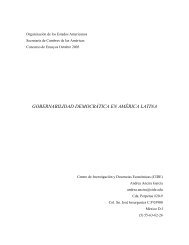The Road to Hemispheric Cooperation: Beyond the Cartagena
The Road to Hemispheric Cooperation: Beyond the Cartagena
The Road to Hemispheric Cooperation: Beyond the Cartagena
You also want an ePaper? Increase the reach of your titles
YUMPU automatically turns print PDFs into web optimized ePapers that Google loves.
●● an Energy Efficiency Training Center in Costa Rica (in conjunction<br />
with <strong>the</strong> Natural Resources Defense Council),<br />
●● a Biomass Center in Brazil, and<br />
●● a Geo<strong>the</strong>rmal Center in El Salvador that would receive<br />
financial support from <strong>the</strong> Inter-American Development<br />
Bank (IDB) and <strong>the</strong> U.S. Department of Energy. 10<br />
<strong>The</strong> first Energy and Climate Ministerial of <strong>the</strong> Americas,<br />
held in Washing<strong>to</strong>n, D.C. on April 15-16, 2010, was attended<br />
by representatives from 32 of <strong>the</strong> 35 governments<br />
in <strong>the</strong> Western Hemisphere. At this ministerial, <strong>the</strong> U.S.<br />
delegation announced that ECPA is premised on at least<br />
seven pillars (Secretary of State Clin<strong>to</strong>n proposed adding<br />
<strong>the</strong> last two at <strong>the</strong> ministerial itself):<br />
1. Energy Efficiency <strong>to</strong> promote best policy practices<br />
through assistance in developing building codes and<br />
o<strong>the</strong>r standards in <strong>the</strong> industrial and residential sec<strong>to</strong>rs,<br />
as well as training for energy audits.<br />
2. Renewable Energy <strong>to</strong> accelerate clean energy deployment<br />
via project support, policy dialogues, scientific collaboration,<br />
and <strong>the</strong> clean energy technology network.<br />
3. Cleaner and More Efficient Use of Fossil Fuels <strong>to</strong><br />
promote clean energy technologies <strong>to</strong> reduce both<br />
conventional pollution and <strong>the</strong> carbon footprint of<br />
fossil fuels, as well as best practices on land use<br />
management.<br />
4. Energy Infrastructure <strong>to</strong> foster modernized, integrated,<br />
and more resilient energy infrastructure, particularly<br />
electrical grids and gas pipelines.<br />
5. Energy Poverty <strong>to</strong> target urban and rural energy<br />
poverty with strategies <strong>to</strong> promote sustainable urban<br />
development and improve access <strong>to</strong> modern clean<br />
energy services and appropriate technologies in rural<br />
areas that can improve public health and reduce fuel<br />
wood use that benefits forest management.<br />
6. Sustainable Forestry and Land Use <strong>to</strong> reduce emissions<br />
from deforestation and forest degradation, and<br />
enhance carbon sequestration in <strong>the</strong> land use sec<strong>to</strong>r, including<br />
through <strong>the</strong> conservation and sustainable management<br />
of forests.<br />
7. Adaptation Assistance <strong>to</strong> developing countries impacted<br />
by climate change.<br />
At <strong>the</strong> 2010 Ministerial, <strong>the</strong> U.S. Department of Energy announced<br />
that it would be providing technical support, including<br />
hosting a workshop, <strong>to</strong> explore <strong>the</strong> potential for building<br />
a Caribbean-wide system using submarine sea cables <strong>to</strong><br />
transmit electricity generated from renewable energy sources.<br />
<strong>The</strong> Energy Department also signed an agreement with<br />
<strong>the</strong> IDB <strong>to</strong> create an Energy Innovation Center <strong>to</strong> allow both<br />
entities <strong>to</strong> coordinate resources <strong>to</strong> facilitate regional projects<br />
and activities. <strong>The</strong> Center was expected <strong>to</strong> serve as a<br />
focal point for accessing <strong>the</strong> Bank’s annual energy financing<br />
pipeline with an initial $1.5 billion in capital for lending<br />
purposes. 11 In addition, <strong>the</strong> Energy Department announced<br />
a partnership between <strong>the</strong> National Renewable Energy<br />
Labora<strong>to</strong>ry (NREL) in Golden, Colorado with scientists and<br />
technology experts in Colombia <strong>to</strong> help identify, evaluate,<br />
and promote technologies for sustainable biomass use in<br />
that country.<br />
At <strong>the</strong> same meeting, <strong>the</strong> State Department released <strong>the</strong><br />
names of three U.S. scientists who would serve as senior<br />
ECPA fellows and travel <strong>to</strong> countries throughout <strong>the</strong> Western<br />
Hemisphere providing advice, sharing experiences, and<br />
consulting with regional counterparts on clean energy, sustainable<br />
landscapes, and adaptation <strong>to</strong> climate change. 12<br />
It was also announced that <strong>the</strong> U.S. Department of Agriculture<br />
would serve as <strong>the</strong> lead agency <strong>to</strong> coordinate U.S.<br />
government technical assistance <strong>to</strong> countries interested in<br />
sharing information <strong>to</strong> expand production and usage of sustainable<br />
biomass energy.<br />
Since <strong>the</strong> April 2010 ECPA Ministerial, Canada has led a<br />
working group on heavy oil, but with representation from<br />
Brazil, Colombia, Mexico, <strong>the</strong> United States, and Venezuela.<br />
This group was formed <strong>to</strong> facilitate <strong>the</strong> exchange of<br />
information on best practices and technological innovation<br />
so as <strong>to</strong> reduce <strong>the</strong> environmental footprint of heavy crude<br />
extraction and development.<br />
Among ECPA projects, Mexico leads a working group on<br />
energy efficiency that includes all of <strong>the</strong> countries of <strong>the</strong><br />
Western Hemisphere and shares best practices and experiences<br />
<strong>to</strong> develop regional partnerships that promote efficiency<br />
and conservation.<br />
<strong>The</strong> <strong>Road</strong> <strong>to</strong> <strong>Hemispheric</strong> <strong>Cooperation</strong>: <strong>Beyond</strong> <strong>the</strong> <strong>Cartagena</strong> Summit of <strong>the</strong> Americas<br />
<strong>The</strong> Brookings Institution ❘ Latin America Initiative<br />
48








